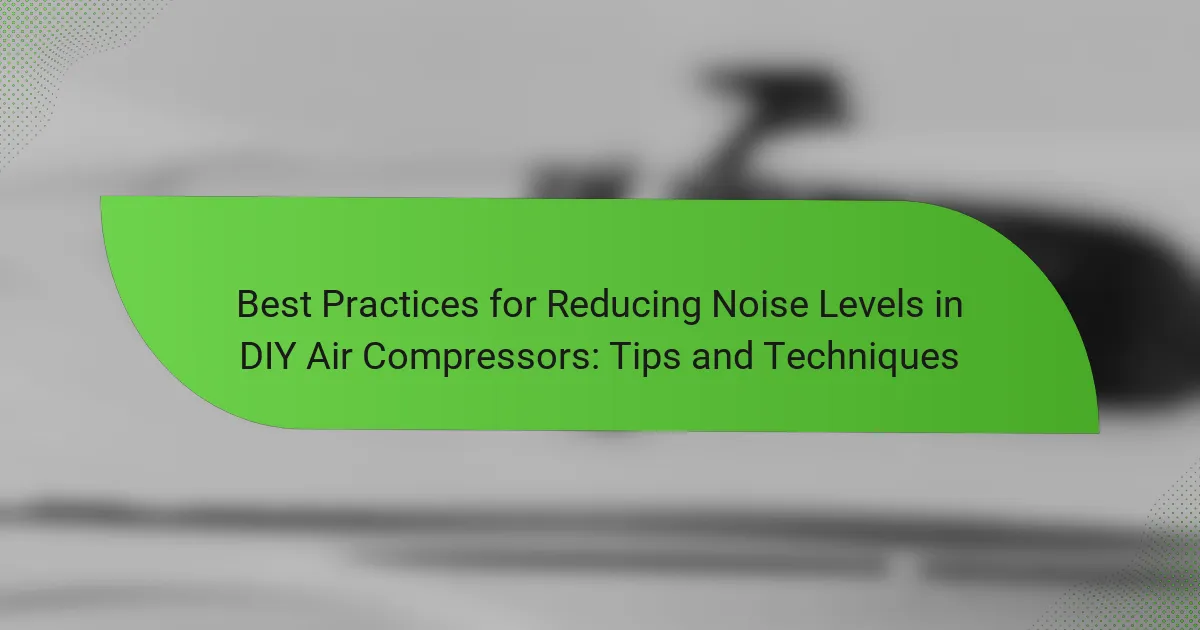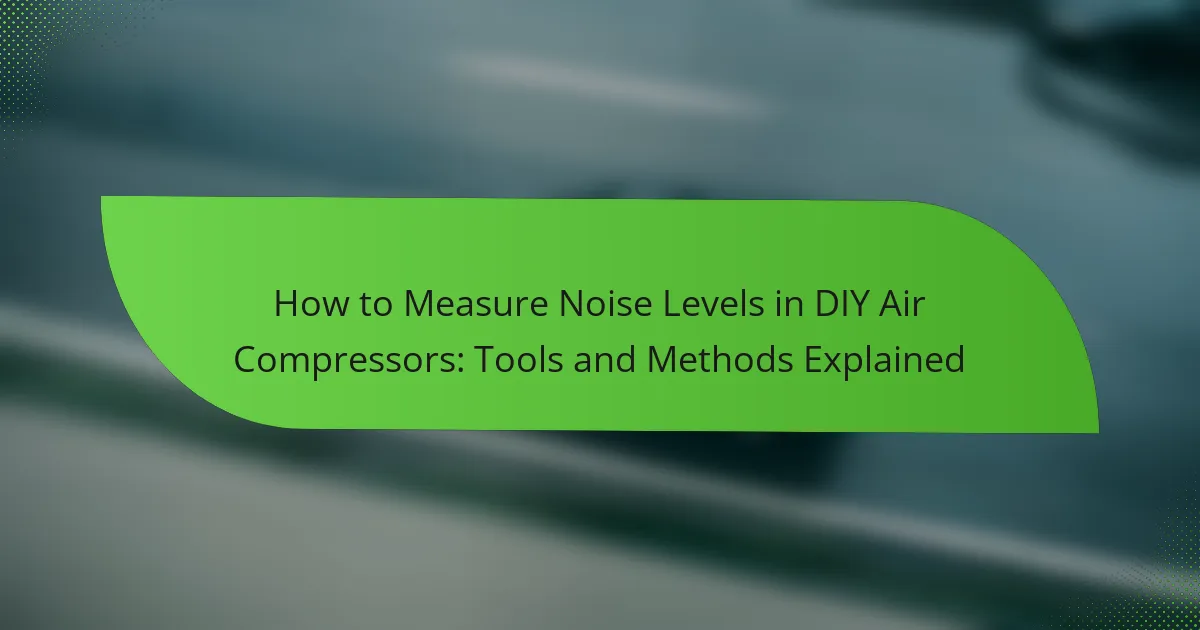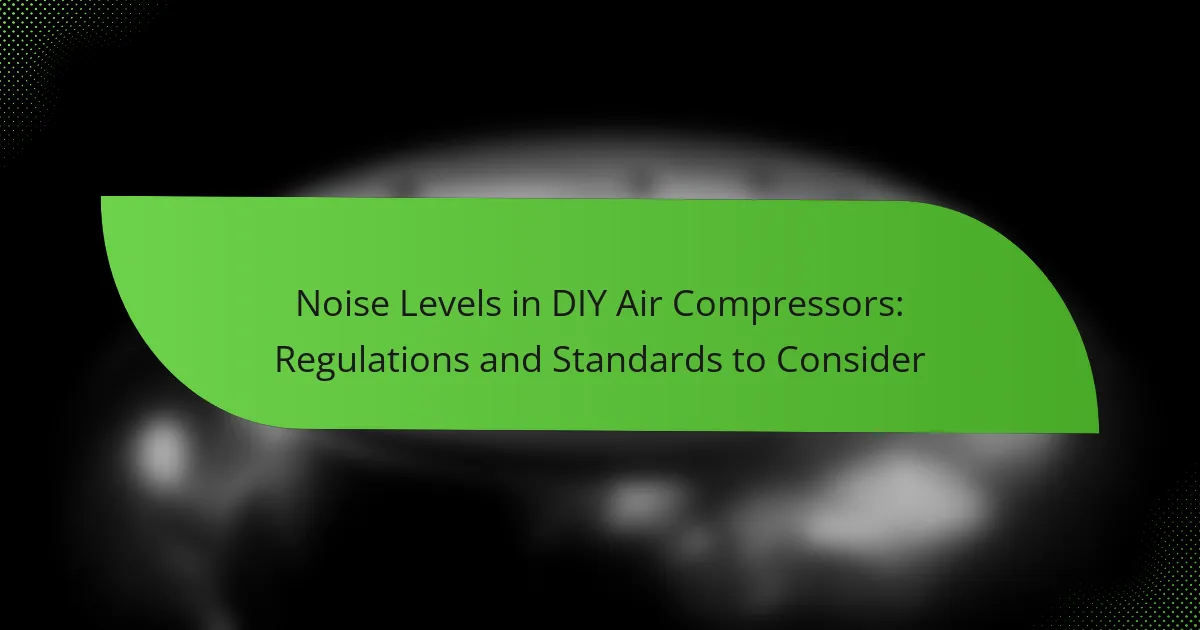Portable DIY air compressors are commonly used tools that operate at varying noise levels, typically ranging from 60 to 90 decibels. Factors influencing these noise levels include motor size, compressor design, operating pressure, and pump type. Smaller, oil-free models tend to be quieter, while larger compressors can produce more noise. Strategies for minimizing noise include using soundproof enclosures, selecting quieter models, and employing vibration-absorbing materials. This article provides a comprehensive overview of the noise levels associated with portable DIY air compressors and offers practical solutions for reducing noise in residential settings.

What are the noise levels of portable DIY air compressors?
Portable DIY air compressors typically operate at noise levels ranging from 60 to 90 decibels. The specific noise level depends on the model and design of the compressor. For example, smaller, oil-free models tend to be quieter, often around 60 to 70 decibels. In contrast, larger, more powerful compressors can reach noise levels of 80 to 90 decibels. This range is comparable to the sound of a vacuum cleaner or heavy traffic. Users should consider these noise levels, especially if using the compressor in residential areas. Reducing noise can be achieved through soundproofing enclosures or selecting quieter models.
How are decibel ratings measured for air compressors?
Decibel ratings for air compressors are measured using a sound level meter. This device captures sound pressure levels in decibels (dB) at a defined distance from the compressor. Typically, this distance is one meter away from the compressor’s operation point. The measurement process occurs in a controlled environment to minimize background noise. The readings are usually taken at various operating conditions, such as idle and full load. This ensures a comprehensive understanding of the noise output. The results help consumers compare different models based on their noise levels. Accurate measurement adheres to standards set by organizations like the American National Standards Institute (ANSI).
What is the significance of decibel levels in noise assessment?
Decibel levels are crucial in noise assessment as they quantify sound intensity. They provide a standardized measure for comparing different noise sources. For example, a decibel level of 70 dB is generally considered the threshold for potential hearing damage with prolonged exposure. Noise assessments often use decibel levels to determine compliance with regulations. These levels help identify areas where noise pollution may impact health and well-being. Accurate measurement of decibel levels can guide noise mitigation strategies. Understanding decibel levels aids in making informed decisions regarding equipment use in residential areas.
How do different decibel levels affect user experience?
Different decibel levels significantly affect user experience. Higher decibel levels can lead to discomfort and stress. For instance, sounds above 85 dB can cause hearing damage over time. Users may find environments with 60-70 dB acceptable for conversation and work. In contrast, levels above 70 dB can disrupt focus and communication.
Research indicates that prolonged exposure to noise levels above 70 dB can affect productivity and well-being. A study by the World Health Organization highlights that consistent exposure to noise can lead to increased anxiety and reduced quality of life. Therefore, understanding decibel levels is crucial for optimizing user experience in environments where portable DIY air compressors are used.
Why is understanding noise levels important for home use?
Understanding noise levels is important for home use because excessive noise can disrupt daily activities and affect well-being. Noise levels are measured in decibels (dB), with higher levels indicating louder sounds. For instance, sounds above 70 dB can lead to hearing damage over time. Additionally, many household tasks require concentration, and loud noises can hinder productivity. According to the World Health Organization, consistent exposure to noise levels above 55 dB can impact sleep quality and overall health. Therefore, selecting appliances with lower noise ratings can enhance comfort and maintain a peaceful home environment.
What are the potential impacts of noise on household activities?
Noise can significantly disrupt household activities. It can hinder communication among family members. Loud sounds may distract from tasks like cooking or cleaning. Concentration is often impaired in noisy environments. Studies show that noise can increase stress levels. Elevated stress can lead to decreased productivity. Furthermore, noise can affect sleep quality, impacting daily functioning. In summary, excessive noise adversely affects various household activities.
How does noise pollution from air compressors affect health?
Noise pollution from air compressors can adversely affect health. Prolonged exposure to high noise levels can lead to hearing loss. It can also cause increased stress levels and anxiety. Research indicates that chronic noise exposure may lead to cardiovascular issues. According to the World Health Organization, noise pollution contributes to sleep disturbances. Sleep disruption can further impact mental health and cognitive function. Studies show that noise above 70 decibels can cause these negative health effects. Therefore, managing noise levels from air compressors is essential for health and well-being.

What factors influence the noise levels of portable DIY air compressors?
The noise levels of portable DIY air compressors are influenced by several factors. Key factors include the compressor’s motor size and type. Larger motors tend to generate more noise. The design of the compressor also plays a significant role. Compressors with sound-dampening features produce lower noise levels. Additionally, the compressor’s operating pressure affects noise output. Higher pressures often result in increased noise. The type of pump used can also impact sound levels. Oil-lubricated pumps typically run quieter than their oil-free counterparts. Lastly, the overall build quality and materials can contribute to noise levels. High-quality materials often minimize vibrations and noise.
How does the design of an air compressor affect its noise output?
The design of an air compressor significantly influences its noise output. Factors such as the type of motor, casing material, and insulation determine noise levels. For example, oil-lubricated compressors tend to operate more quietly than their oil-free counterparts. The shape and size of the compressor also play a role; larger tanks can reduce noise by providing more air storage. Additionally, the presence of sound-dampening features, like acoustic enclosures, can further minimize noise. Research indicates that compressors with well-designed mufflers produce lower decibel levels. Therefore, thoughtful design choices can lead to quieter operation in air compressors.
What role do motor types play in noise generation?
Motor types significantly influence noise generation in portable DIY air compressors. Different motor designs produce varying noise levels due to their construction and operation. For instance, induction motors typically generate less noise compared to universal motors. This is primarily due to the smoother operation and reduced vibration of induction motors.
Moreover, the speed of the motor affects noise output. High-speed motors often create more noise due to increased mechanical stress and airflow turbulence. Additionally, the materials used in motor construction contribute to sound levels. Motors with metal housings can amplify noise, while those with sound-dampening features tend to be quieter.
In summary, motor type, speed, and construction materials are critical factors in determining the noise generation of air compressors.
How do compressor size and power affect noise levels?
Compressor size and power significantly influence noise levels. Larger compressors typically generate more noise due to their increased power output. The power of a compressor is often measured in horsepower (HP) or watts. Higher power usually correlates with louder operation.
For example, compressors with more than 2 HP often produce noise levels above 80 decibels (dB). In contrast, smaller units, like those under 1 HP, may operate around 60 dB. Noise levels are also affected by the compressor’s design and components.
Research indicates that sound insulation and vibration dampening can reduce noise levels, regardless of size and power. Therefore, while size and power are critical factors, design features also play a crucial role in overall noise output.
What are the common noise levels associated with different types of air compressors?
Common noise levels for air compressors vary by type. Portable air compressors typically range from 60 to 80 decibels. Oil-free compressors often produce 70 to 90 decibels. Pancake compressors usually operate at 80 to 90 decibels. Scroll compressors are quieter, averaging 60 to 70 decibels. Rotary screw compressors can reach 75 to 95 decibels. These levels can impact home use, as higher decibels may cause disturbances. Noise levels are measured in decibels, which quantify sound intensity. Understanding these levels helps consumers choose suitable compressors for home environments.
What are the typical decibel ranges for portable air compressors?
Typical decibel ranges for portable air compressors are between 60 dB and 90 dB. Most home-use models operate around 70 dB. This level is comparable to normal conversation. Higher-end models can reach up to 90 dB, similar to a lawn mower. Noise levels depend on the compressor’s design and motor type. Electric compressors are generally quieter than gas-powered ones. Understanding these ranges helps users select appropriate models for home use.
How do oil-lubricated compressors compare to oil-free models in terms of noise?
Oil-lubricated compressors generally produce more noise than oil-free models. This is due to the mechanical components and the lubrication process involved in oil-lubricated systems. Oil-free compressors utilize a different design, which often results in quieter operation. Studies show that oil-free compressors can operate at decibel levels around 60-70 dB, while oil-lubricated models may reach levels of 70-90 dB. The added noise from oil-lubricated compressors can be attributed to the movement of oil and the vibrations from the motor. Therefore, for quieter operation, oil-free compressors are typically preferred in residential settings.

What strategies can be employed to minimize noise from portable DIY air compressors?
To minimize noise from portable DIY air compressors, several strategies can be employed. Using rubber mats under the compressor can absorb vibrations and reduce noise transmission. Enclosing the compressor in a soundproof box can also significantly lower noise levels. Additionally, selecting a compressor with a lower decibel rating can help in reducing overall noise. Regular maintenance of the compressor ensures it operates efficiently and quietly. Using sound-dampening materials around the compressor area can further minimize noise impact. Finally, operating the compressor during less disruptive hours can help manage noise concerns in residential areas.
How can users select quieter models of air compressors?
Users can select quieter models of air compressors by checking the decibel (dB) ratings. Models with lower dB ratings typically produce less noise. For example, compressors rated at 60 dB are significantly quieter than those at 80 dB. Users should also consider the type of compressor; oil-lubricated models often operate more quietly than oil-free ones. Additionally, users can look for features such as sound insulation or noise-reducing technology. Reading customer reviews can provide insights into real-world noise levels. Finally, comparing brands known for quieter operation can aid in selection.
What features should be considered when choosing a low-noise compressor?
When choosing a low-noise compressor, consider the decibel (dB) rating. Lower dB ratings indicate quieter operation. Look for models with ratings below 60 dB for home use. Evaluate the compressor’s design, as enclosed or sound-insulated units reduce noise. Check the motor type; brushless motors typically produce less noise. Consider the compressor’s duty cycle, as continuous operation can lead to increased noise. Assess the size and weight, as portability can affect noise levels during movement. Finally, review user feedback on noise performance to ensure satisfaction.
How does proper maintenance affect noise levels?
Proper maintenance reduces noise levels in portable DIY air compressors. Regularly servicing the compressor ensures that all components function efficiently. This includes checking and replacing worn parts, which can lead to increased vibrations and noise. Clean air filters and lubricated moving parts minimize friction. A well-maintained compressor operates at optimal performance, producing less sound. Studies show that poorly maintained equipment can be up to 10 decibels louder than properly maintained counterparts. Therefore, consistent maintenance is crucial for maintaining lower noise levels.
What are some practical tips for reducing noise during operation?
To reduce noise during operation of portable DIY air compressors, consider the following tips. Use soundproofing materials around the compressor. This can significantly dampen noise levels. Place the compressor on a rubber mat to minimize vibrations. Ensure proper maintenance to keep the compressor running smoothly and quietly. Operate the compressor in a well-ventilated area to reduce echo. Use a quieter model or one specifically designed for low noise output. Lastly, schedule operations during less disruptive hours to minimize impact on others. These strategies collectively contribute to a quieter operation.
How can soundproofing techniques be applied in a home workshop?
Soundproofing techniques can be effectively applied in a home workshop by using various materials and methods. First, adding acoustic panels to walls can absorb sound waves. These panels reduce echo and lower overall noise levels. Second, sealing gaps and cracks in doors and windows prevents sound leakage. Weather stripping and door sweeps are effective for this purpose. Third, using heavy curtains or soundproof drapes can further block noise from outside. Fourth, installing a soundproof door can significantly minimize sound transfer. Additionally, placing rugs or carpets on the floor helps absorb sound impact. Finally, using soundproofing foam in corners can reduce low-frequency noise. These techniques collectively improve the acoustic environment in a home workshop.
What accessories can help in noise reduction while using air compressors?
Accessories that can help in noise reduction while using air compressors include sound enclosures, mufflers, and vibration isolators. Sound enclosures are designed to encapsulate the compressor, reducing sound transmission. Mufflers can be attached to the exhaust to minimize noise output. Vibration isolators help absorb vibrations, which can contribute to noise levels. Additionally, using hoses with noise-dampening features can further reduce sound. These accessories are effective in lowering decibel levels, making air compressor operation quieter.
What are the best practices for using portable DIY air compressors in residential areas?
Best practices for using portable DIY air compressors in residential areas include minimizing noise levels and ensuring safe operation. Select a compressor with a low decibel rating, ideally below 70 dB, to reduce noise impact. Operate the compressor during designated hours to avoid disturbing neighbors. Use sound-dampening materials, like mats or enclosures, to further lessen noise. Ensure proper ventilation to prevent overheating during extended use. Regular maintenance, such as checking for leaks and changing oil, promotes efficiency and safety. Follow the manufacturer’s guidelines for setup and operation to prevent accidents. Lastly, consider using air hoses and extensions to maintain distance from residential areas while working.
The main entity of this article is portable DIY air compressors, with a focus on their noise levels and decibel ratings. The article provides an overview of the typical noise ranges these compressors operate within, highlighting the factors influencing noise output, such as motor type, size, and design. It discusses the significance of understanding decibel levels for home use, including their potential impact on health and household activities. Additionally, strategies for minimizing noise, selecting quieter models, and best practices for operation in residential areas are examined, offering practical guidance for users.



